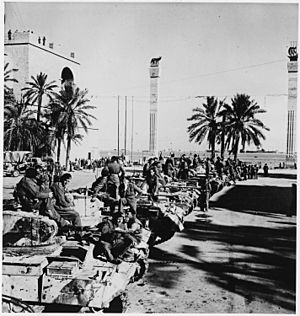Allied administration of Libya facts for kids
Quick facts for kids
Allied administration of Libya
|
|||||||||||
|---|---|---|---|---|---|---|---|---|---|---|---|
| 1943–1951 | |||||||||||
|
Flag
|
|||||||||||

The three regions of Libya during the Allied occupation: Tripolitania and Cyrenaica were British-administered, while Fezzan was French
|
|||||||||||
| Status | Military Administration | ||||||||||
| Capital | Tripoli | ||||||||||
| Common languages | English, French, Italian, Arabic | ||||||||||
| History | |||||||||||
| 13 May 1943 | |||||||||||
| 10 February 1947 | |||||||||||
|
• Became the Kingdom of Libya
|
24 December 1951 | ||||||||||
| Currency | Algerian franc (Fezzan-Ghadames) Egyptian pound (Cyrenaica) Military Authority Lira (Tripolitania) |
||||||||||
|
|||||||||||
The Allied administration of Libya was a time when Libya was controlled by the Allied powers after World War II. This period lasted from May 13, 1943, until Libya became an independent country in 1951.
Libya, which used to be a colony of Italy, was split into two main parts during this time:
- The British Military Administration of Libya
- The French Military Territory of Fezzan-Ghadames
After 1949, both areas were also overseen by the UN.
Who Administered Libya?
During the Allied administration, different countries took charge of different parts of Libya.
- The United Kingdom managed the regions of Tripolitania and Cyrenaica.
- France took control of the Fezzan region.
Even though the Allies were in charge, Libya was still officially considered "Italian Libya" until February 1947. That's when Italy signed a peace treaty. In this treaty, Italy officially gave up all its claims to its former colonies, including Libya.
The British set up a military administration. The French forces occupied the area that was once known as the Italian Sahara. They even asked to make Fezzan a permanent part of their own colonial empire. Interestingly, many of the Italian government workers stayed in their jobs during this time.
The British started training Libyans to work in their own government. However, Italian workers continued to be employed in the capital city of Tripoli. The old Italian laws also stayed in place during the war.
In the Fezzan region, which didn't have many people, the French military set up their own administration. They worked with local leaders to manage the area. French soldiers often acted as both military and civil leaders. Some parts of Fezzan were even linked to French-controlled areas in Algeria and Tunisia. This made some Libyan nationalists worried that France might try to keep Fezzan forever.
Libya's Path to Independence

The Allied occupation of Libya began in February 1943. This happened after Allied forces pushed out the last German and Italian soldiers.
After the war, the British continued to manage Tripolitania and Cyrenaica. The French kept control of Fezzan. In 1944, a leader named Idris returned to Libya from exile. He was an important figure for Libya's future.
In 1947, Italy officially gave up its claims to Libya in a peace treaty with the Allies. This was important because it meant Libya could stay united.
During this time, some difficult events happened for the Jewish community in Libya. Many Jewish people faced challenges and felt unsafe. Because of these events and the creation of the state of Israel, many Libyan Jews decided to move to Israel. Between 1948 and 1951, over 30,000 Libyan Jews moved there. By the 1970s, most of the remaining Jewish people in Libya moved to Italy.
The future of Italy's former colonies, like Libya, was a big question after the war. In 1945, the Allied powers agreed that these colonies should not be returned to Italy. They discussed different ideas for Libya's future. The United States suggested that the United Nations (UN) should oversee Libya. This would help Libya prepare to govern itself. Other countries had different ideas, but they couldn't agree.
Finally, the United Kingdom suggested that Libya should become independent right away. This idea helped break the deadlock.
Idris as-Senussi, a respected leader, represented Libya in the UN discussions. On December 24, 1951, Libya declared its independence. Representatives from Cyrenaica, Tripolitania, and Fezzan joined together. They formed a new country called the United Kingdom of Libya. Idris as-Senussi was offered the crown and became the first king.
The new country had a federal government. This meant that the three regions – Cyrenaica, Tripolitania, and Fezzan – had some autonomy (self-rule). The kingdom also had three capital cities: Tripoli, Benghazi, and Bayda. Two years later, in 1953, Libya joined the Arab League.
Libya's independence on December 24, 1951, marked the end of the Allied occupation. It was a historic moment. Libya became the first country to gain independence through the help of the United Nations. It was also one of the first former European colonies in Africa to become independent.
See also
- 1945 Tripoli pogrom
- 1948 Tripoli pogrom


